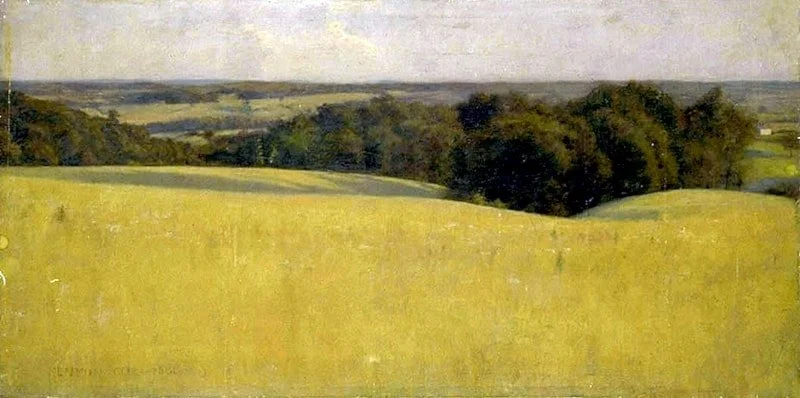The Classic Point of View: Kenyon Cox's Timeless Wisdom for Representational Landscape Painters
Landscape, Kenyon Cox
Kenyon Cox’s The Classic Point of View: Six Lectures on Painting (1912) offers an inspiring exploration of classical ideals that resonate deeply with contemporary representational landscape painters who aim to honor tradition while forging their own artistic voice. Cox’s timeless reflections on art’s foundations challenge us to rethink the role of permanence, discipline, and beauty in the ever-evolving art world.
In this post, we’ll examine how Cox’s ideas—his celebration of the Classic Spirit, his critique of modernity’s disruptions, and his advice on balancing tradition with innovation—can guide today’s painters in creating work that is both rooted in history and uniquely their own.
Flying Shadows by Kenyon Cox
The Classic Spirit: A Love of Permanence and Tradition
Cox opens with a powerful definition of the Classic Spirit:
"The Classic Spirit is the disinterested search for perfection; it is the love of clearness and reasonableness and self-control; it is, above all, the love of permanence and of continuity. It asks of a work of art, not that it shall be novel or effective, but that it shall be fine and noble." (p. 3)
For today’s representational landscape painters, this ethos emphasizes the enduring value of creating work that is not merely trendy but timeless. Cox’s insistence on tradition as a link to the past rather than a constraint on creativity inspires artists to explore historical techniques and motifs while imbuing them with personal vision.
"It wishes to add link by link to the chain of tradition, but it does not wish to break the chain." (p. 5)
After Harvest by Kenyon Cox
Tradition as a Foundation for Innovation
Cox acknowledges that tradition need not stifle individuality. Instead, it provides a foundation upon which artists can build:
"Their effort was to vitalize tradition and turn it to new uses; to gain new knowledge but to crystallize it in forms reminiscent of the past." (p. 11)
This perspective resonates with modern painters striving to uphold time-honored principles of composition, color harmony, and craftsmanship while exploring contemporary interpretations of nature.
Lengthening Shadows by Kenyon Cox
The Perils of Photographic Realism
Cox critiques the rise of photography, noting its unintended impact on painting:
"The most damaging [influence on modern art] was probably the invention of photography. The result...has been greatly to increase the tendency of the young artist to consider the exact imitation of nature as the primary problem of art." (p. 13)
For representational painters today, this serves as a reminder to avoid the trap of hyper-realism and instead prioritize the artistic interpretation of nature. Painting’s power lies in its ability to evoke emotion and beauty through design and abstraction—qualities a camera cannot replicate.
Landscape by Kenyon Cox
Restoring the Love of Beauty and Discipline
Cox’s call for a return to the Classic Spirit remains as vital today as it was in 1912:
"The scientific spirit, the contempt of tradition, the lack of discipline and the exaltation of the individual have very nearly made an end of art. It can only be restored by the love of beauty, the reverence for tradition, the submission to discipline, and the rigor of self-control." (p. 22)
In an art world often dominated by conceptualism, landscape painters can find inspiration in Cox’s emphasis on beauty and technical mastery. These principles encourage artists to cultivate disciplined practice and thoughtful design, ensuring their work resonates on a deeper level.
September Sunshine by Kenyon Cox
The Dual Purpose of Painting
Cox’s assertion of painting’s dual purpose offers a guiding principle for today’s landscape painters:
"The primary business of painting is to create a beautiful surface, beautifully divided into interesting shapes, enlivened with noble lines, varied with lovely and harmonious colors. Its secondary business is to remind the spectator of things he has seen and admired in nature, and to create the illusion of truth." (p. 23)
This hierarchy—beauty first, representation second—invites painters to focus on the aesthetic and emotional impact of their work, transcending mere depiction to achieve something truly memorable.
Conclusion
Kenyon Cox’s The Classic Point of View provides a rich framework for representational landscape oil painters seeking to balance tradition with individuality. By embracing the Classic Spirit, revitalizing tradition, and prioritizing beauty and discipline, contemporary artists can create work that honors the past while forging a meaningful path forward.
As Cox reminds us, tradition is not a limitation but a vital thread connecting us to the noble and lovely works of history. Let us add our own link to the chain, ensuring its strength and continuity for generations to come.





